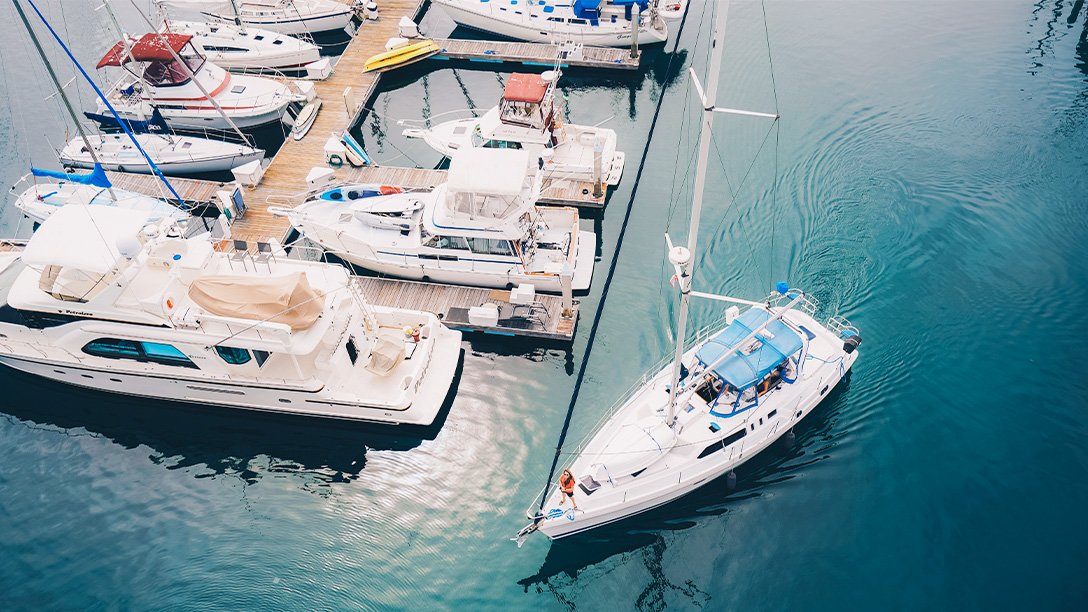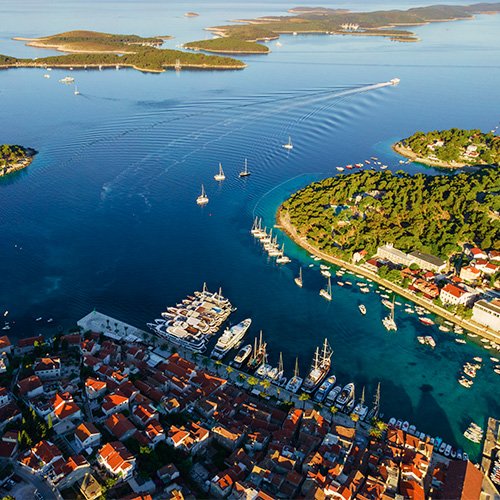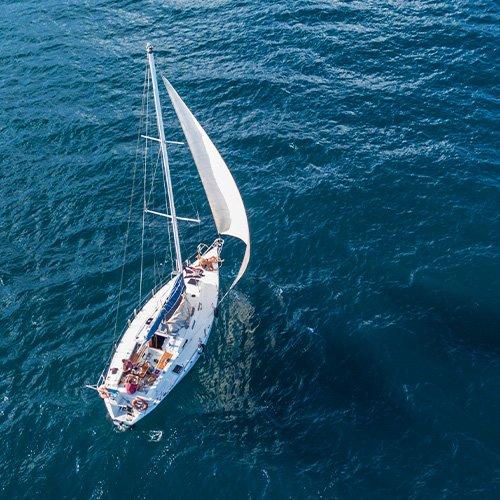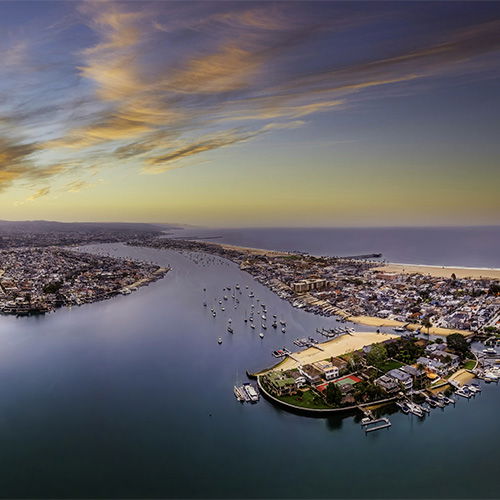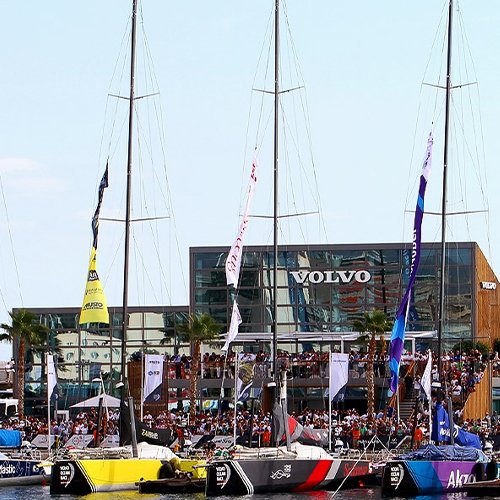Sailing, at first glance, might appear straightforward. But those who have faced the vastness of the open sea know better. Embarking on a sailing journey without the right training and hands-on experience can swiftly transform a picturesque voyage into a challenging, and sometimes hazardous, adventure. Sailing is not just about catching the wind; it's a multifaceted skill that demands a nuanced understanding of several elements.
Set Sail with Confidence!
Dive into the world of sailing with our comprehensive and FREE sailing guide, exclusively available on capetanos.com. Whether you're a beginner just starting your maritime journey, or an experienced sailor looking to refine your skills, our guide is tailored just for you.
Given the extensive range of competencies needed, numerous training opportunities are on offer for budding sailors. These range from introductory courses, which lay down the fundamentals of boating safety, to advanced modules that delve into complex navigation strategies and competitive racing dynamics. Numerous reputed sailing schools have also recognized the need for structured learning pathways, offering comprehensive certification programs. These programs are tailored to equip students with the robust skill set and knowledge base essential for operating a sailboat safely and effectively.
However, while formal training sets the foundation, the art of sailing is truly honed with practice. Immersing oneself in the water, facing its myriad challenges, and employing varied techniques are irreplaceable. It's this experiential learning, coupled with formal education, that molds a confident and skilled sailor, ready to embrace the sea's allure while respecting its might.

Set Sail with Confidence
capetanos.comFactors determining the cost of a sailing course
a. Type of sailing courses
Setting sail, be it as a novice or seasoned sailor, demands rigorous training to ensure safety and mastery over the marine elements. For those new to this realm, beginner sailing courses provide an immersive introduction. They fuse practical water-based experiences with theoretical insights, steadily progressing from basic to more complex concepts. The objective? Equip newcomers with the aptitude to navigate dinghies in moderate conditions while emphasizing safety.
For those already familiar with the basics, advanced sailing courses offer a deeper dive. They transcend foundational knowledge, addressing intricate sailing facets from meticulous boat handling to the excitement of racing. Moreover, these courses often venture into extended maritime expeditions, allowing sailors to refine their skills amidst diverse and sometimes unpredictable marine environments.
Diverse sailing aspirations demand specialized training:
- Cruising Courses: Ideal for those drawn to long-distance ocean voyages or living aboard, these courses teach essential aspects like passage planning, provisioning, and onboard system management. They also delve into varied anchoring techniques tailored for different conditions.
- Offshore Sailing: These courses cater to thrill-seekers drawn to the vast, unpredictable open ocean. Emphasis is placed on weather forecasting, sea survival techniques, advanced navigation, and managing boats in turbulent weather.
- Maintenance and Repair Courses: Central to maritime safety is a well-maintained vessel. These courses, offered by various marinas and institutions, combine theoretical and practical lessons, covering everything from engine maintenance to sail repair and hull inspections.
b. Duration of a sailing course
In the vast world of sailing education, two prominent course types stand out based on duration: weekend courses and extended sailing courses. Each caters to specific needs and preferences, and understanding their differences can help aspiring sailors choose the best fit.
Weekend Courses
- Convenience and Intensity: Perfect for those with busy lives, weekend courses condense essential lessons into a short timeframe. They provide a rapid introduction to sailing, allowing participants to get a feel for the sport without a lengthy time commitment.
- Focused Curriculum: Given the time constraint, weekend courses typically prioritize foundational concepts, ensuring that participants grasp the basics of boat handling, safety procedures, and rudimentary navigation.
- Immediate Immersion: With only a couple of days at their disposal, weekend courses dive straight into hands-on experiences. There's minimal downtime, ensuring participants are continuously engaged, either on-the-water or in focused theory sessions.
Extended Sailing Courses
- Comprehensive Learning: Longer courses offer a more thorough exploration of sailing. Over multiple days or even weeks, participants delve deeper into both theoretical aspects and practical skills, from intricate navigation techniques to advanced boat management.
- Progressive Skill Development: With the luxury of time, extended courses can introduce concepts in a graduated manner. As students master one skill, they seamlessly transition to more advanced topics, ensuring a structured learning trajectory.
- Varied Experiences: Extended courses often incorporate diverse sailing scenarios. From tranquil morning sails to navigating challenging weather conditions, participants experience the full spectrum of maritime environments. This breadth of experience prepares them for real-world sailing adventures.
- Opportunity for Reflection: Unlike the continuous hustle of weekend courses, longer courses allow for periodic breaks and debrief sessions. These intervals give students time to reflect on their experiences, ask questions, and internalize lessons.
Choosing between a weekend course and an extended sailing course largely hinges on individual preferences and commitments. Whatever the choice, the allure of the open waters and the thrill of sailing await.
c. Location
The magnetic charm of sailing attracts followers globally. However, the cost of sailing courses can vary widely depending on the country or even specific regions within that country. The impact of currency is significant: in nations with strong currencies, sailing courses may appear costlier to foreigners, but for residents, these prices often align with their average earnings. Coastal areas or those steeped in maritime tradition often have numerous sailing schools, promoting competitive rates.
Conversely, inland areas with courses on lakes or rivers might have higher rates due to their unique offering.
Renowned sailing destinations like the Caribbean or certain Mediterranean regions may have elevated prices because of high tourist demand.
Locations with consistent wind and stable climatic conditions can offer courses without many disruptions, potentially leading to better prices. In contrast, high-risk areas, susceptible to abrupt weather changes, might have added costs for safety measures and insurance.
Regions where sailing gear and upkeep are pricier, perhaps due to import tariffs or limited local production, might transfer these expenses to learners. Additionally, in places mandating official sailing certifications, courses that confer these credentials could be more expensive. Furthermore, in locales with a deep-seated maritime tradition, sailing can be viewed as a cultural treasure, which can influence course pricing, especially if they employ traditional sailing techniques and vessels.
In summary, sailing course prices are shaped by various regional elements. For budding sailors, grasping these factors ensures they get both value and a culturally immersive learning experience.
d. Institution Reputation
Sailing's allure attracts many, and the institutions teaching this art vary widely. Elite sailing schools are renowned, often boasting decades of prestige, top-tier instructors, and a comprehensive range of courses. Their graduates benefit from a recognized credential, advanced techniques, vast networking opportunities, and potential career paths. Consequently, the fees for these institutions are steeper, reflecting the quality of education and resources.
Conversely, local sailing schools, deeply rooted within their communities, offer a more hands-on and tailored approach. While they may lack global prestige, they compensate with intimate knowledge of local conditions, a personalized curriculum, and affordable rates. Their strength lies in fostering a community spirit, immersing students in local sailing events and traditions.
In essence, while elite institutions present a global, world-class perspective, local schools provide a grounded, personalized sailing education. Both pathways offer distinct experiences, ensuring every aspiring sailor finds their fitting course.
e. Included Resources
Embarking on a sailing journey is exciting, and the boat you choose to learn on affects your experience. Here's a breakdown of sailing boats type:
- Dinghies: Small and responsive, best for beginners learning basic handling and balance.
- Keelboats: Larger, offering stability, ideal for intermediate sailors focusing on teamwork and navigation.
- Yachts: Luxurious and meant for extended trips, suitable for advanced courses covering long journeys and advanced navigation skills.
- Catamarans: Stable and fast, ideal for those wanting to explore shallow waters or tropical cruising.
- Skiffs: High-performance and speedy, used in advanced racing.
- Traditional Boats: Echo the heritage of sailing, focusing on classic navigation and seamanship.
Your sailing gear is equally important. Depending on the weather, you might need a wetsuit or wind-blocking jackets. Quick-dry fabrics are beneficial. Protect your hands with sailing gloves and ensure a good grip with specialized boating shoes. Always prioritize safety: life jackets for larger boats and buoyancy aids for dinghies are essential. Don't forget essentials like a sailing knife, UV-protected sunglasses, sun cream, and suitable headgear. Safety and comfort are key when mastering the art of sailing.
f. Certification & Accreditation
Achieving sailing certifications, like those from the American Sailing Association, can enhance your self-assurance on the waters and pave the way for broader sailing ventures. Typically, the certification fee is encompassed in the initial course fee, which might fluctuate based on the specific certificate and its issuing body.
Here are some noteworthy certifications to consider:
- The American Sailing Association (ASA) - provides a spectrum of certificates for sailors, spanning from novices to experts. The expenditure for ASA's certifications generally lies between 500 USD and 1,500 USD.
- The International Yacht Training (IYT) - offers diverse certifications for sailors, encompassing titles like International Crew, International Bareboat Skipper, and International Flotilla Skipper. Acquiring an IYT certification might set you back anywhere from 1,000 USD to 3,000 USD.
- The Royal Yachting Association (RYA) - has an array of certificates for sailors, including accolades like Start Yachting, Competent Crew, Day Skipper, and Coastal Skipper. Securing an RYA certification typically costs between 500 USD and 1,500 USD.

Factors Determining the Cost of Sailing Courses
capetanos.comAverage Costs Based on Popular Locations
Cost of sailing courses in United States
Whether you're a boat owner or not, embarking on a sailing journey has never been easier. The American Sailing Association (ASA) is at the forefront, offering their 'Learn to Sail' programs tailored for both novices and seasoned sailors. Their comprehensive curriculum isn't limited to just teaching you to sail; it encompasses an in-depth grasp of environmental nuances, crucial safety protocols, technical mechanics, and the finesse required to master the art of sailing.
Meanwhile, US SAILING stands as another significant pillar in the sailing community. They not only provide an array of courses nationwide but also champion events such as the One-Design Sailing Symposiums, Safety at Sea Seminar, and National Championships. Additionally, they play a pivotal role in certifying race officials and establishing uniform sailing regulations.
Let's delve into some of the USA's premier sailing academies:
The Boothbay Harbor Yacht Club, with roots tracing back to 1870, has been the epicenter of racing and summer social activities. They offer a plethora of sailing courses, from beginner levels to advanced racing techniques. Primarily taught on J22 sailboats, a 2-hour beginner's sail is priced from 200 USD, with members availing a special rate.
Regarded as the apex of sailing education in NYC, this school ensures a comprehensive experience for both novices and experts. They offer flexible learning formats, including group sessions or personalized classes. Additionally, students can pursue an American Sailing Association certification. Course prices commence at 550 USD for group sessions.
Not just another boating club, Blue Pacific Boating prides itself on their meticulous attention to every vessel and personalized instruction to students. Catering to all skill levels, their starting course, which offers a nurturing learning environment, is available from 850 USD.
Ranked amongst America's elite, this sailing school is characterized by its experienced leadership and dedicated teaching staff. Their multifaceted approach to education includes pre-course materials, in-class instructions, and on-water practicals. Their group lessons begin at 295 USD per person, providing a comprehensive learning experience.
Embarking on a sailing journey is not just about mastering the boat but understanding the sea, and these institutions ensure you're equipped for both.
Cost of sailing courses in Europe
If you're an adept sailor or a beginner keen to explore the realm of sailing, a summer journey across Europe offers thrilling adventures. From hopping between picturesque islands bathed in turquoise waters to relaxing on sun-kissed shores and stargazing from the deck, every journey offers a fresh horizon to explore. With Europe's plethora of awe-inspiring destinations, the allure of mastering the art of sailing is hard to resist. Here's a closer look at some of the continent's most renowned sailing academies:
Since its establishment in 1969, HORC has been at the forefront of offshore sailing education in Greece. While its roots are in Athens, its influence stretches nationwide, with branches from Corfu to Chalkida. Leveraging multimedia presentations and hands-on sessions, their experienced instructors impart both theoretical and practical knowledge. The school boasts seven dedicated training vessels, and advanced and racing modules for sailing aficionados. To get a detailed fee structure, one must reach out to them directly.
Established in 1995 with the Croatian Ministry of Science and Education's blessing, Ultra Sailing School has successfully groomed over 3,200 sailors. Many of its alumni now stand out as accomplished sailors, skippers, and boat owners. In addition to its comprehensive training program, the school collaborates with the Port Authority for license examinations. With courses ranging from family sessions to group classes, the tuition starts at a competitive 1090 EUR for a two-day stint.
RCNB is not just about gaining sailing qualifications; it's about imbibing the very essence and values of the sport. With a dedicated staff committed to holistic learning, the institution offers a range of courses, from PER to YACHT CAPTAIN. Emphasizing the virtues of nature immersion and teamwork, RCNB's programs are recognized for their quality and effectiveness. The Recreational Boat Skipper course is priced starting at 530 EUR, with online options available for added convenience.
As one of the UK's premier sailing institutions, RYA's Yachtmaster training scheme is designed to mold beginners into competent sailors and skippers. Tailored to suit individuals and groups, including children, their courses offer both condensed and spread-out formats. Those aiming for international maritime recognition can pursue the RYA/MCA Yachtmaster Certificates of Competence, with commercial endorsements for aspiring professionals. Their introductory Cruising Level 1 course spans a minimum of two days, with fees commencing at 424 GBP.
Cost of sailing courses in Australia
Blessed with a vast shoreline and optimal sailing conditions, Australia has become a hotspot for sailing aficionados. Amidst its numerous prestigious sailing schools, the Royal Sydney Yacht Squadron (RSYS) reigns supreme as the country's top sailing academy. Nestled in Kirribilli, Sydney, and with a rich history dating back to 1862, the RSYS is more than just a sailing school - it's a private member's haven dedicated to the art of sailing. Catering to everyone from young enthusiasts aged 7 to adults with a passion for the sea, the RSYS is truly inclusive.
For adults embarking on their sailing journey, the RSYS Sailing Academy’s Discover Sailing courses offer an unparalleled experience. Revel in the scenic beauty of the Harbour, hone your sailing techniques, and forge friendships along the way. The academy welcomes both RSYS members and the general public, presenting four comprehensive levels that transform beginners into adept skippers ready for new horizons. All sessions utilize the Club's robust fleet of Elliott 7s keelboats, ensuring a secure sailing environment without the concerns of capsizing. Each boat accommodates up to 5 sailors, including certified Australian Sailing instructors who are both knowledgeable and approachable.
Course sessions are slated for Wednesday mornings (exclusively for women as part of the 'Ladies of the Sea' initiative) and Sunday mornings (Open Courses accessible to all). Regardless of the day chosen, participants will engage with the standardized Australian Sailing Discover Sailing program. The 'Ladies of the Sea' sessions provide a supportive atmosphere for women to explore keelboat sailing, while the Open Courses on Sundays are designed for a diverse group of sailors, irrespective of age, gender, or proficiency level. Course fees commence at 650 USD for non-RSYS members and are discounted to 520 USD for RSYS members.
In summary, the Royal Sydney Yacht Squadron stands as a beacon of excellence in Australia's sailing landscape. With its deep-rooted history, diverse courses tailored to all levels of experience, and a unique blend of inclusivity and prestige, the RSYS offers both novices and seasoned sailors an unparalleled opportunity to embrace and master the art of sailing. For anyone seeking to embark on a transformative sailing journey in Australia, the RSYS remains the gold standard.
Cost of sailing courses in Asia
Asia's sailing culture seamlessly blends its deep-seated maritime traditions with the latest yachting techniques. From China's age-old junks to the Arabian Sea's dhows, juxtaposed against the state-of-the-art marinas in locales like Singapore and Phuket, Asia offers a diverse maritime spectrum. A rising trend in the sailing community has been the growth of notable sailing institutions that cater to an eager domestic audience as well as international sailing devotees. These institutions, many affiliated with prestigious global sailing organizations, deliver courses that span from fundamental introductions to intricate navigational training. Given Asia's varied marine terrains and distinct challenges, it's not only an adventurer's paradise but also a prime hub for systematic sailing education, making it a magnet for sailing enthusiasts.
Initiated in 2017, the Phuket Yacht Club Sailing School transitioned to direct club management in 2019, subsequently achieving International Sailing Schools (ISS) accreditation in 2020. The school's growth trajectory has been remarkable, with nearly 100 youth sailors benefiting from the program annually. The school offers training sessions on weekends and during school vacations, catering to budding sailors ranging from beginners to advanced racers aged between 7 and 17. Adult learners aren't left behind, with tailored courses in single-handed ILCA and double-handed Tasar. Personalized lessons adjust to individual experience levels and available schedules. Course fees commence at 2500 THB (Junior; Private) and 3500 THB (Adult; Private).
Dinghy sailing at HKSF welcomes all ages, emphasizing that it's not just for the youth but also the young-hearted. The federation's scheme progressively elevates a novice to a competitive sailor. HKSF also provides a Pleasure Vessel Operators Level 2 Course, a mandatory certification in Hong Kong for powered boat operators. Their introductory course, HKSF Level 1, offers a comprehensive overview of dinghy sailing, emphasizing basic boat handling and foundational knowledge. Typically spanning two full days, precise course details, including fees, can be obtained from their affiliated clubs or training centers.
Serving as Singapore's official sailing authority, SingaporeSailing is committed to propagating sailing across all age brackets. For those intrigued by the call of the sea and winds, the federation has curated an enticing curriculum. The Adult Sailing Programme, designed for recreational enthusiasts, imparts essential skills for leisurely sailing. This immersive four-day course, running from 9 am to 5:30 pm, is priced at 607 USD for Singapore residents and 726 USD for international participants.
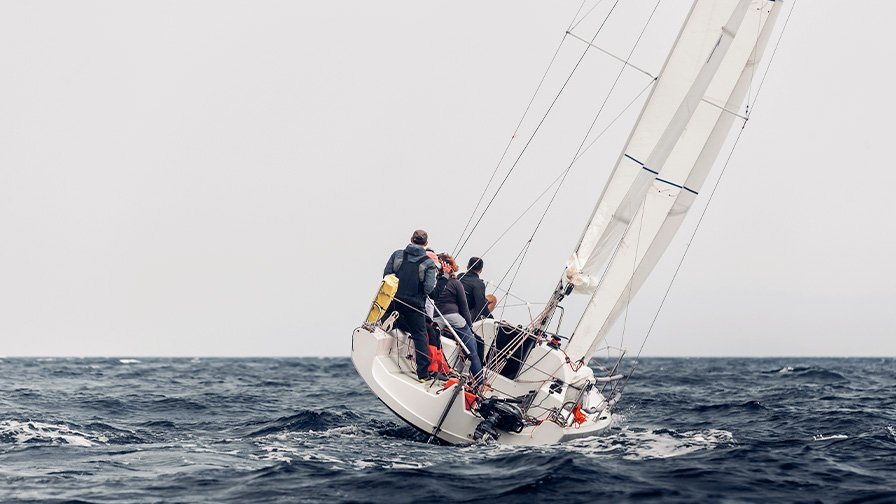
Average Costs Based on Popular Locations
capetanos.comAdded Costs Often Overlooked when choosing a sailing course.
Examination Fees
Fees associated with examinations in sailing courses represent the costs set by sailing academies or maritime certification entities for those aspiring to attain certain sailing credentials or permits. These fees offset several operational expenses, including crafting the exam, employing adept examiners, equipment usage, and, in some cases, upholding safety protocols. The exact fee often fluctuates based on the course's stature and intricacy. They aren't just about gauging theoretical proficiency but also ensure a candidate's practical capability in maneuvering and operating a boat safely. It's common for these examination fees to stand apart from the main course fees and they might be due when booking or taking the test. For context, the RYA, the UK's leading authority on sailing that we touched upon earlier in this piece, has examination costs starting from 70 GBP for its Short-Range Certificate, with prices rising based on the exam's complexity. It's vital to note that each school or organization will have distinct fee structures; hence, always refer to the respective sailing institution for comprehensive details.
Equipment Purchase or Rental?
An often-overlooked financial aspect is the cost associated with equipment purchase or rental. Sailing requires specialized gear, ranging from personal flotation devices, appropriate sailing attire, and footwear, to more advanced navigation tools or safety equipment for higher-level courses. While some schools might include basic gear in their course fees, many do not.
Renting equipment might seem like a cost-effective solution initially, but frequent rentals can quickly add up, sometimes making purchasing a more economical choice in the long run. Additionally, having personal, well-fitted equipment can enhance the safety and comfort of the learning experience. Prospective sailors should always inquire about equipment costs and policies when considering a course and factor these expenses into their budgeting.
Travel and Accommodation
Choosing to take a sailing course in a location away from home can undeniably enhance the overall experience, immersing you in new waters and cultures. However, while the allure of such an adventure is strong, it's vital not to overlook the associated travel and accommodation expenses. Your choice of destination can substantially influence the overall costs, from the transportation methods required—be it by air, train, or road—to the range and price of available lodgings, whether they're luxury resorts, quaint bed-and-breakfasts, or budget-friendly hostels. It's worth noting that most sailing schools focus their fee structures on the instructional aspect and seldom incorporate travel or housing allowances.
Consequently, exploring sailing courses in different regions, states, or countries might see your expenses climbing higher than if you were to enroll in a course closer to home. Before committing to such an adventure, ensure you conduct a thorough financial assessment, accounting for these added costs, to guarantee a smooth and stress-free learning journey.
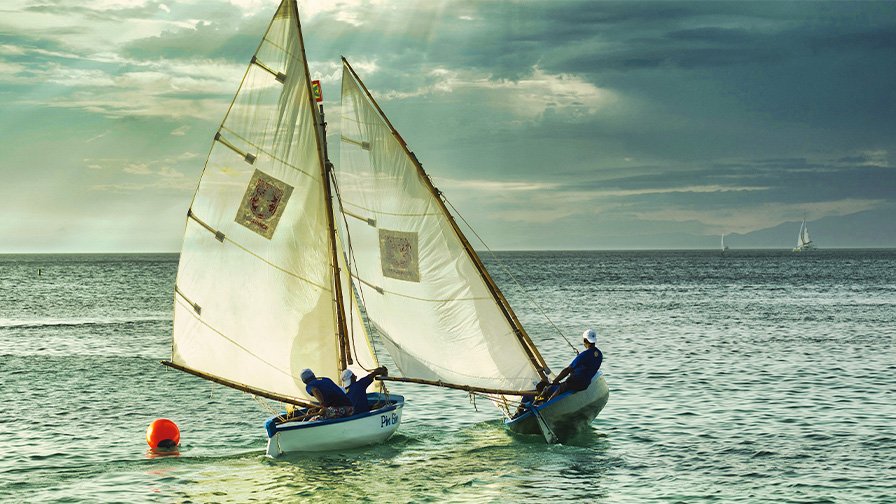
Added Costs Often Overlooked
capetanos.comWays to Save on Sailing Course Costs
Early Bird Discounts
Investing in a sailing course can be quite a financial commitment. Therefore, it's advisable to look for opportunities to reduce the expense. One of the most cost-effective ways to do this is to secure an early bird discount. These discounts are often available to those who register for courses well in advance and can range between 10% and 30% off the regular price.
To stay informed about such offers, one of the best approaches is to subscribe to the newsletter of the sailing school you're interested in. This will enable you to receive timely email updates about upcoming courses and special promotional offers, including early bird discounts.
By planning ahead and staying informed, you can enjoy a rewarding sailing experience without breaking the bank.
Group booking a sailing course
Group sailing classes offer a multitude of benefits, both in terms of finances and the social experience. Opting for a group booking can be considerably more economical than signing up for a private lesson. Think of it as buying in bulk; the more slots you book, the less each slot costs individually. This provides an excellent incentive for you to rally your friends and make the venture a collective one.
Imagine the joy of learning the ropes of sailing alongside your closest mates, the camaraderie, the shared laughs, and the mutual encouragement. It becomes not just an educational experience but a memorable adventure. And if, perchance, your circle of friends doesn't share your enthusiasm for the waves and wind, don't let that deter you. Enrolling in a group class can be a golden opportunity to expand your social network. You'll be paired with other individuals who, like you, have a penchant for sailing. As you navigate the waters together, you'll not only learn the technical aspects of sailing but also forge bonds with fellow enthusiasts.
Local Club Memberships
As we've touched upon earlier in the article, a vast majority of sailing schools extend the privilege of membership to their patrons. While the immediate thought might be the allure of discounted rates on sailing courses and other programs they facilitate, the true essence of membership transcends these monetary benefits.
When you enroll as a member of such esteemed institutions, you are not merely signing up for courses; you're integrating into a thriving community of sailing enthusiasts. This provides a fertile ground to cultivate lasting friendships with individuals who resonate with your fervor for the sea.
Beyond the camaraderie, the membership often unlocks the doors to exclusive maritime events. Whether it's exhilarating races, prestigious regattas, or festive gatherings that celebrate the spirit of sailing, members often find themselves on the guest list of these coveted occasions, deepening their connection to the world of sailing.
Off-Peak Season Rates
During the bustling peak seasons, many services and activities, including sailing courses, tend to have heightened prices due to increased demand. The allure of the open sea and the charm of sailing often lead to courses being fully booked, sometimes months in advance. However, for those with flexible schedules and a keen interest in maximizing value, the off-peak season presents an enticing opportunity.
Not only do many sailing schools offer courses at reduced rates during these less busy times, but there's also the added advantage of having a broader array of dates and times to select from. This flexibility ensures learners can choose sessions that align perfectly with their commitments. Additionally, with fewer students vying for slots, instructors can offer a more personalized, in-depth teaching experience.
Those enrolling in off-peak sessions may also find the waters less congested, leading to a serene and focused learning environment. So, if you're looking to master the art of sailing without breaking the bank, and crave a more tailored and relaxed experience, setting sail during the off-peak season might be your best course of action.
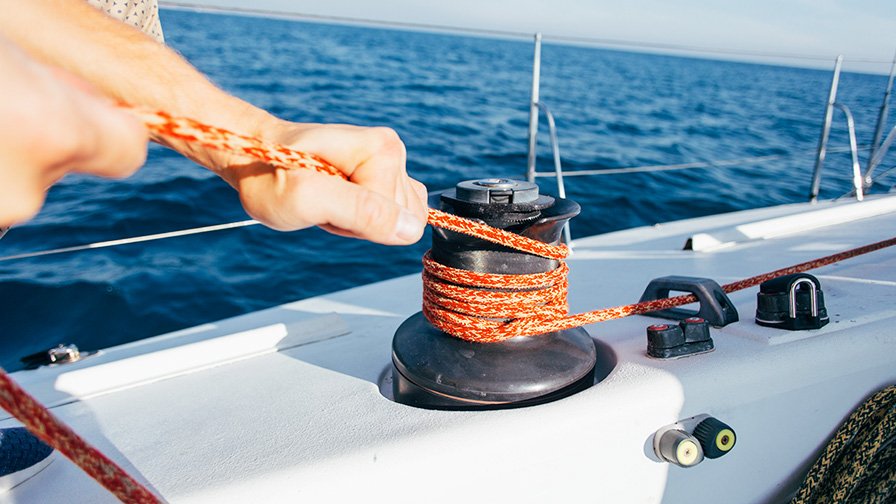
Ways to Save on Sailing Course Costs
capetanos.comThe Value of Investment in a sailing course
Safety first
Safety is the linchpin of the sailing world, holding together all aspects of this intricate and rewarding endeavor. It's a domain where the synergy between theoretical knowledge and hands-on experience truly demonstrates its immense value. While textbooks, simulations, and classroom settings provide an understanding of the theoretical aspects, real-life experiences on the water bring these theories to life, cementing their importance in a sailor's mind.
Experiential learning, which encompasses real-time navigation, understanding water currents, and adapting to rapidly changing weather conditions, is invaluable.
However, without the bedrock of established safety protocols and navigational tenets, such experiences can become overwhelming, if not outright dangerous. This is why a profound understanding of safety measures, marine signals, and navigation rules is paramount. When sailors merge this foundational knowledge with practical on-the-water experiences, they're not just learning; they're arming themselves with the tools to respond confidently to unexpected challenges and make critical decisions with clarity and assurance.
Skills & Mastery
Embarking on the journey of sailing without a comprehensive understanding is akin to navigating uncharted waters without a compass. Within the vast domain of sailing, a holistic understanding demands a grasp of varied principles. This spans from the seemingly simple, yet crucial, knowledge of navigation rights to the intricate dynamics of wind direction and sail orientation.
This theoretical foundation, while being a treasure trove of knowledge, acts as more than just a repository of facts. It functions as a sailor's primary compass, setting the initial trajectory and providing context for the wealth of experiences to come. However, as with many disciplines, theory, despite its immense value, can only illuminate the path to a certain extent. The vast ocean of sailing mastery lies beyond the horizons of mere theoretical understanding.
True expertise and proficiency in sailing are achieved when one marries theory with hands-on experience. Whether that's feeling the salt spray on one's face as they cut through actual waves or harnessing the power of modern technology via virtual reality simulations, it's the tactile, real-world (or virtually real) experience that imprints the nuances of sailing into a mariner's psyche. By marrying the wisdom of textbooks with the lessons of the sea or simulation, an aspiring sailor transforms into a master mariner, ready to harness the wind and waves with skill and confidence.
Career Opportunities in the Boating Industry
The leisure boating sector is a vast and varied landscape, brimming with opportunities globally.
As highlighted by the Persistence Market Research report, North America dominates the global scene for recreational boating. Simultaneously, Europe boasts strong markets with nations like Italy, the UK, Germany, and France at the forefront. Often compared in glitz and appeal to the film industry, the boating world offers a platform for individuals to unearth hidden talents, understand the essence of collaboration, hone quick decision-making skills, and delve deep into both the technical and artistic facets of boating – be it as a hobby, a job, or a full-fledged career. It's an endeavor that resonates with individuals across age groups.
To carve a niche for oneself in this industry, it's essential to specialize in a specific domain, continually enhancing one's proficiency through education, hands-on training, and consistent practice. Before charting a course in this field, it's crucial to survey the entire industry, identifying the skills requisite for one's desired role. For those aiming to make a splash in the boating world, cultivating a diverse skill set and gaining practical experience in multiple areas can pave the way for success. Dive deeper into the myriad career avenues in boating with this detailed article.
Conclusion about prices of sailing course costs
The world of sailing presents a multifaceted tapestry, interwoven with elements of safety, skill mastery, and abundant career opportunities. The cost of venturing into this domain, while influenced by various factors, is significantly anchored in ensuring robust safety protocols, acquiring a comprehensive blend of theoretical and practical knowledge, and exploring diverse career paths.
Emphasizing the significance of in-depth training, the value one receives in return, both in terms of skill acquisition and potential career avenues, far outweighs the initial investment. It's imperative for aspiring sailors to recognize that while costs can be quantified, the empowerment derived from quality training, the thrill of mastering the seas, and the potential for a rewarding career in boating offer unparalleled value for money. Investing in sailing is not just a financial decision; it's a commitment to acquiring a life skill, fostering personal growth, and opening doors to boundless horizons.
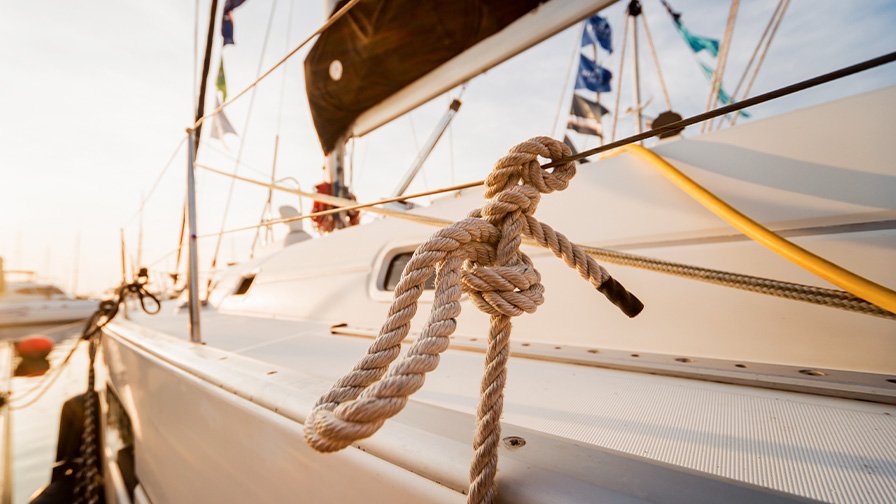
The Value of Investment in a sailing course
capetanos.comFAQ about sailing course cost
Is it mandatory to take a sailing course before buying a boat?
While it isn't legally mandated to complete a sailing course before buying a boat, it's crucial to note the benefits of having a boating qualification. In certain situations, you might be restricted from operating your vessel without a recognized certification.
How long does a typical beginner's sailing course last?
A beginner's sailing course is designed to introduce novices to the fundamental principles and techniques of sailing. While the duration can vary based on several factors, it typically ranges from 2 to 4 days. The exact length can be influenced by the curriculum offered by the training institution, the depth of topics covered, and the location where the course is held.
Are there any online sailing courses available?
Certainly, online sailing courses are available in today's digital age. Many sailing schools have adapted to modern times by offering theoretical lessons online. While these online sessions provide valuable knowledge, it's essential to understand that hands-on practical training is pivotal for refining your sailing skills and gaining comprehensive experience.
Can I take specialized courses after a basic course?
After completing a basic sailing course, you can move on to pursue specialized sailing courses. These specialized courses cater to specific skills or areas of sailing. Typically, the course description will indicate if it's designed for beginners or advanced sailors, ensuring you select one that matches your proficiency level.
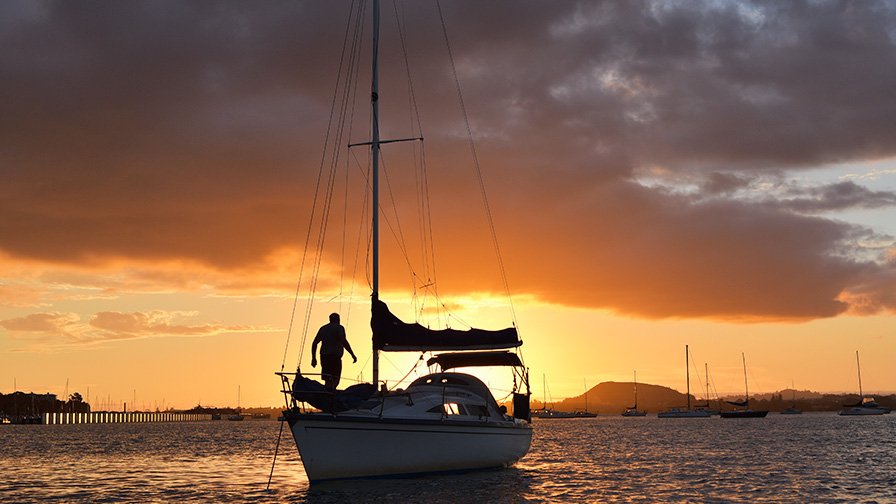
FAQ about sailing course cost
capetanos.comCapetanos.com’s free sailing guide
For those who have ever felt the call of the waves or have been captivated by the vast expanse of the sea, diving into the world of sailing could be a thrilling and enriching adventure.
As a starting point, you might want to consider enrolling in an introductory course at a nearby sailing school. These institutions not only provide hands-on training but also instill the foundational knowledge that every sailor should possess.
Packed with tips, techniques, and secrets of the seas, this guide is your passport to master the waves. Don't miss out on this opportunity to elevate your sailing experience.
Download your free guide now at capetanos.com and embark on a new adventure!
Beyond the initial stages, the realm of sailing is vast and multifaceted. There's always something new to discover, be it advanced techniques, specialized equipment, or historical narratives. And in today's digital age, a plethora of online resources await those eager to deepen their understanding and appreciation of sailing from the comfort of their homes.
It's true that embarking on a sailing journey might come with its costs, but it's an investment that promises immeasurable returns. If you've ventured into the world of sailing, or if you're on the cusp of starting, we're eager to hear from you. Do you have questions that this article hasn't covered? Or perhaps you have a tale from the high seas that you're itching to share? Join our community of sailing enthusiasts by leaving a comment below. Let's navigate the waters of this beautiful journey together!
